Even though this article is from a couple of years ago, it was just brought to my attention. It contains good statistics on what is going on in the hair transplant business, for those of your interested in such things.
Hi Dr Rassman,
I’m fairly concerned about losing my hair, to the extent where I’ve been taking Propecia for a couple of months in a bid to slow down the hairloss process.
I’ve noticed a lot of men emailing you who are very, very anxious about losing their hair. While I would much prefer to keep my hair, I draw the line at having grafts etc. If my hair loss became that bad I would simply accept it and shave my hair Bruce Willis style.
My question is this-when would you recommend counseling to men who are profoundly anxious about hair loss? I think there should be a time and place for this. Sometimes, perhaps it’s a case of come to terms with it and age gracefully!
 Stress contributes to hair loss in those genetically impacted. Finasteride (Propecia) works to block the hair loss and prevent it from happening in most men. Anything that reduces stress is also a good idea, so if counseling work for you, then go for it. The fear of hair transplantation is something that reflects general ignorance. My job is not to convert you or get you to reverse your opinion as to what line you will not cross, but my two hair transplants were the most non-events of my life (in regards to the actual procedure). Most of my patients tell me the same thing, and the benefits certainly deal with the stress directly. One of my patients is a psychologist who had 18 years of psychoanalysis to help him deal with his hair loss. The first of two transplant procedures yielded wonderful results. He said to me that he wasted his money for 18 years, when in one day he solved his problem and the stress went away as the hair grew in.
Stress contributes to hair loss in those genetically impacted. Finasteride (Propecia) works to block the hair loss and prevent it from happening in most men. Anything that reduces stress is also a good idea, so if counseling work for you, then go for it. The fear of hair transplantation is something that reflects general ignorance. My job is not to convert you or get you to reverse your opinion as to what line you will not cross, but my two hair transplants were the most non-events of my life (in regards to the actual procedure). Most of my patients tell me the same thing, and the benefits certainly deal with the stress directly. One of my patients is a psychologist who had 18 years of psychoanalysis to help him deal with his hair loss. The first of two transplant procedures yielded wonderful results. He said to me that he wasted his money for 18 years, when in one day he solved his problem and the stress went away as the hair grew in.
Tags: stress, hairloss, hair loss, anxiety, anxious, psychiatry, mental
Dr. Rassman,
I am a 25 year old male with extremely thin hair. Normally this would not be a concern but I had a medial temporal head fracture and a 12 inch scar on the left side of my skull. I do not want to loose the rest of my hair but dont want it to look to obvious that I had a procedure.
1. Is getting a transplant a life long quest with someone my age?
2. Should I resort to other methodologies before trying surgery?
- Hair transplantation should not be a lifelong quest. I am not sure where you would be getting that information.
- Hair transplantation is a great tool to disguise scars on the scalp. We have treated visible scars and have seen them largely disappear. With respect to other methodologies, you can try make up/ concealing agents to cover the area such as DermMatch. A hair transplant procedure is a cosmetic surgery, which means that the procedures are not medically necessary from an insurance point of view, but may be necessary from a personal view of what you want to look like.
You can always send a photo of your scar to me for review (reference this post), or if you are near one of our offices, you could come in for a consult.
Tags: scar, hairtransplant, hair transplant, hairloss, hair loss, fracture
I’ve been on testosterone replacement for 2 years. I’ve recently had to start (hgh) therapy also. I’ve now noticed hair loss in the front area of my head and in the crown. I don’t know whether to stop all hormone replacement which I apparently need or try taking finasteride? I’m worried about the sexual side effects obviously of finasteride. Seems like a catch 22 to me. Low hormone levels are a danger in themselves but I don’t want to lose my hair. I ‘m sure this is a common problem but would like some thoughts on treatments. I’m 57 years old and just NOW am seeing hair loss. Is there any evidence or data saying that HGH can cause hair loss? It seems like it really got bad when I added that to my therapy 3 months ago?? Thanks for any help or opinions you may have . Regards
HGH and testosterone treatments cause hair loss, big time.
If you are worried about the 1% sexual side effect of taking finasteride, you should understand that the side effect does go away once you stop taking the medication. In other words, if you have androgenic hair loss and want to do something about it, finasteride can only help. If you are one of the minority 1% of the patients who experience the sexual side effect, stop taking it completely or try cutting the pill in half (50% dose). As with all drugs, you should consult your doctor before starting or stopping any medication.
Taking finasteride with HGH and testosterone may help reduce the hair loss effect. For many of our readers, it is important to note that the use of HGH and testosterone is part of an anti-aging routine offered by many doctors. This man did not say why he was taking HGH and testosterone, but many men feel revitalized from its use. Often it is used with aggressive anti-oxidant therapies as well. Most men want to feel years younger and more sexual, and the combination of HGH and testosterone does make this happen. The cost in actual dollars is expensive, but the cost in hair may not be reversible.
Tags: testosterone, hairloss, hair loss, hgh, finasteride, propecia
gday doc,
great blog.
l’ve been on 1mg finasteride for about 9 mths and have recently noticed increased shedding (about 2-3 times more hair than usual).
lve read that finasteride causes synchronization of the hair cycle and as such this can occur and might be taken as a sign that the medication is effective.
Is this correct?
No one really knows for sure. I have heard reports from patients and readers such as yourself that starting finasteride may cause shedding. Aside from the anecdotal evidence, I have not heard or read about a scientific research on this phenomenon. I would hope that the shedding is the result of the drug and the hair going into another growth cycle rather than an acceleration of the hair loss that is due to your genetics. Time will tell the answer here as the shedding should stop and reverse by the 4th month if it is caused by a change in your hair cycle.
Nevertheless, the effectiveness of finasteride (Propecia) has been well studied and documented. Thus, it would not be a good idea to stop taking the medication if you are experiencing hair loss. The hair loss may be worse if you stop the medication as your body will play “catch up” and go back to the state as if you were never on the drug.
Tags: finasteride, hairloss, hair loss, propecia, cycle
I have a 1 to 2mm scar from a strip proceedure. Can you tell me will new closure techniques be able to improve this. My scar starts to show when I cut my hair to a grade 3. Is fue into the scar a better option for someone like me? Can you do the surgery or recommend someone in Europe?
Many Thank
A 2mm scar is fairly small, so I would hope that an excision and trichophytic closure would be the best way to go. I do not have a surgical recommendation for you in Europe, although the techniques that I would use are fairly straight forward in the hands of an expert. As I do not travel to Europe to perform surgery, if you wanted me to do it you’d have to travel to California to see me.
Tags: trichophytic, closure, hairtransplant, hair transplant, scar, repair
Dear Doctor;
My hair regrowth regimen consists of the following…1 .5mg Avodart soft gel every morning, then at night, 2% Ketoconazole Shampoo, under occlusion, for up to 1 hour. I do not use Rogaine Foam, or any other Minoxidil product. I have been doing this now for 5 weeks and see no real change in my crown/vertex thinning. Does this sound like a good regimen? Should I take the Avodart at night instead of the morning? How long would you suggest I give the regimen before I should at least start to see some regrowth? Thanks!
Hair regrowth from known medications can not be seen clearly for 8-12 months. That is because the hair cycle is about 4-6 months and then there is a period where the hair must grow out at 1/2 inch per month. I do not endorse the use of Avodart at this time for treating hair loss and have spoken many times about my preference with Propecia. As you may already know, Propecia (finasteride) is FDA approved for treating hair loss — Avodart (dutasteride) is not.
Tags: propecia, finasteride, dutasteride, avodart, hairloss, hair loss
What is this about?
Over 80 Clinical Studies Prove New Apple-derived Treatment Improves Hair Growth Without Side Effects
I have been impressed with this approach. Having read about it in the medical journals before, I would think it has value and it seems to be worth a try. I’m not endorsing the product for which this press release is announcing, but I’m simply saying that the procyandin B-2 in this product might be good to try.
Tags: rogaine, minoxidil, hairloss, hair loss, procyandin, apple
Dear Doc,
I understand that once a person stops using Propecia he will lose hair that he normally would have lost if he wasn’t taking Propecia. My question is though, would discontinuing Propecia cause a person to lose hair that they normally would not have lost? Thanks.
Normal hair is ‘indifferent’ to Propecia, so stopping the drug will have no effect on hair that is not genetically impacted by male patterned balding.
Tags: finasteride, hairloss, hair loss, propecia
Here’s a story about a dermatologist who had a hair transplant when he was 25 years old, in 1975. Forgive the blurriness of the photo below.
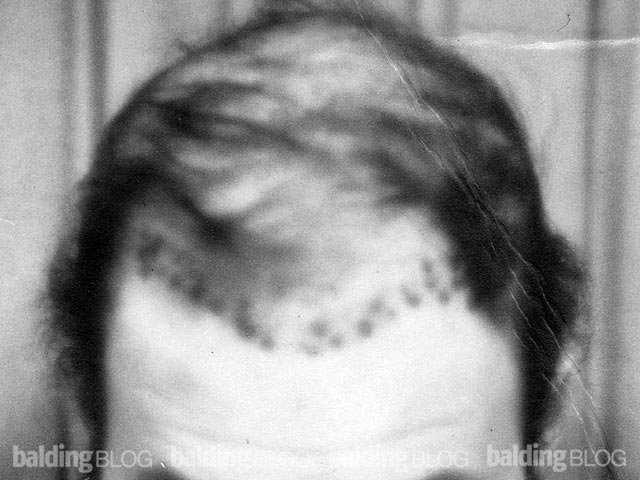
What is particularly important about this first picture is the amount of hair that he actually had when the transplant process was started. He was clearly thinning his hair in the Norwood Class 6 balding pattern and if he were treated today, he would have been put on finasteride (Propecia) to halt the hair loss and hopefully lock in the Norwood Class 6 pattern. When he had the plugs put in, the hair was still there, although clearly heavily miniaturized. The photo above was taken in the first month after the surgery and the hideous looking islands reflected grafts that contained between 20-30 hairs and crusting after the surgery. The crusts which are shown here are only a few weeks old, but in those days, the patients were deformed for months after the surgery as the healing progressed very slowly. The only good news for this man was that many of the hairs failed to grow, reducing the pluggy appearance, simply because of the failure of hairs to grow. His first procedure put two lines of plugs in the frontal hairline, which were followed up with many more plugs at another surgical session.
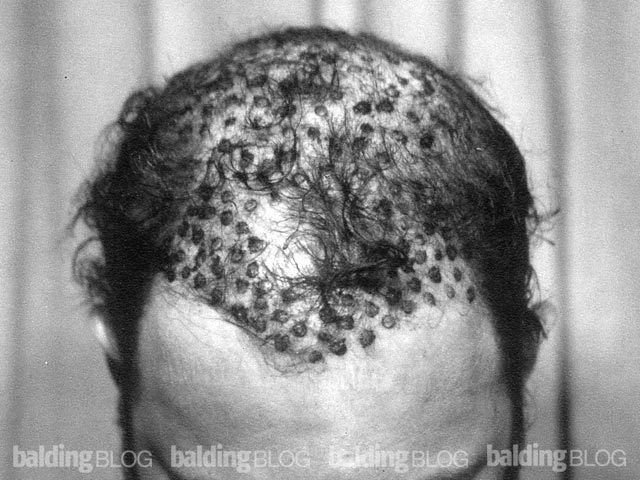
 He eventually lost all of his hair native in the Norwood Class 6 pattern. The grafts were taken out of his donor area with hollow drills measuring slightly under 1/4 inch which left him with white spots about 1/4 inch round that could easily be seen through the thinned out donor area. After he completed his surgery, he developed a comb-over to hide the plugs, but the hairline was still deforming and even with a comb-forward style, he could not hide the hideous grafts.
He eventually lost all of his hair native in the Norwood Class 6 pattern. The grafts were taken out of his donor area with hollow drills measuring slightly under 1/4 inch which left him with white spots about 1/4 inch round that could easily be seen through the thinned out donor area. After he completed his surgery, he developed a comb-over to hide the plugs, but the hairline was still deforming and even with a comb-forward style, he could not hide the hideous grafts.
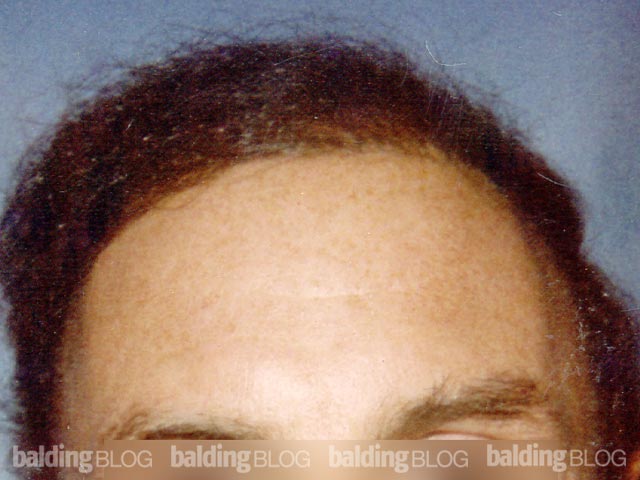
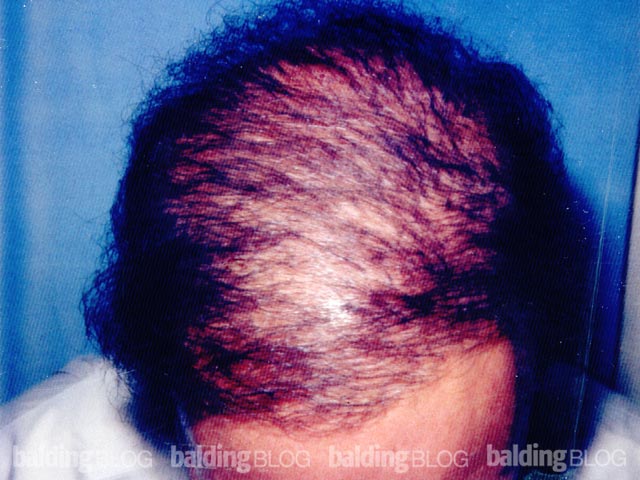
In 1988, he went to Denver and had a few hundred micrografts placed in front of the hairline by the inventor of the micrograft. The focus was to put camouflage in front of the plugs. This surgery did much to soften his look. Still, on meeting people in his dermatology practice, eyes focused on his hairline and the top of his head. That convinced him that he needed to find a better solution. Eventually, he had grafts removed, received dermabrasion to smooth out the bumps and cobblestoning, and had about 8 laser hair removal procedures to kill off the hair that he worked so hard to put there. To deal with the deformities created by the harvesting techniques, he had finely stippled tattoos created to look like hair and this hides most of the scars on the side and back of his head. His final look, one of a bald man, seems to work for him. His approach to his problem was creative and it showed me the value of the old saying: “Necessity is the mother of invention”. This doctor, armed with a unique set of skills (dermatologist) and facing his deformities every day in the mirror, applied his talents to solve his problem. He got there and now people who see him as a doctor, look straight into his eyes, not at his head. Congratulations!
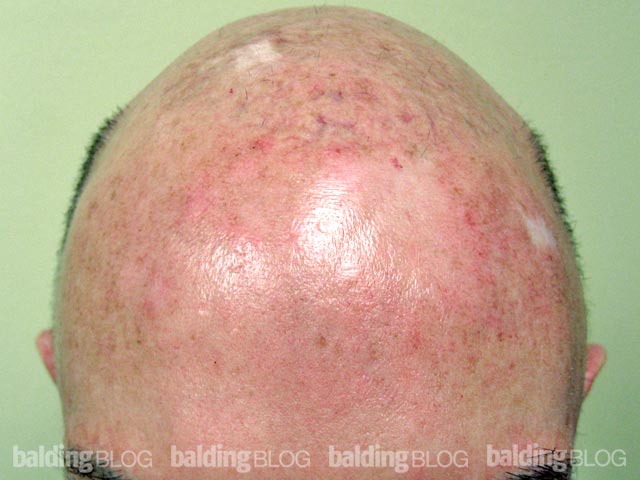
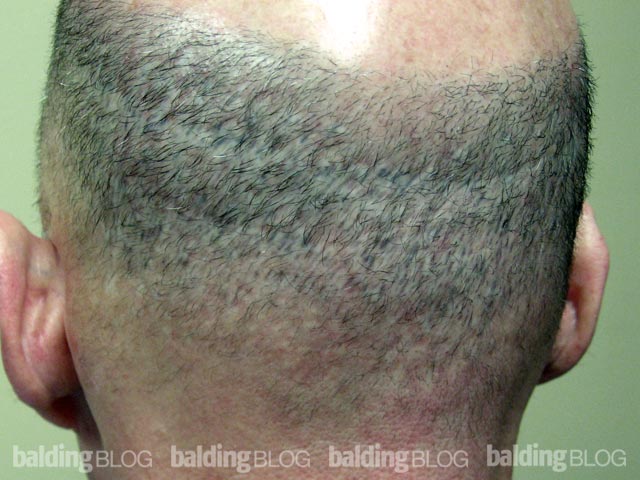
Note: Most people see someone just like this man walking down the street, at a movie, in a restaurant, or at an airport. There is a perception that this pluggy look is the look of a hair transplant, but this type of procedure, if done today, would be clear malpractice and not acceptable in this litigious legal climate. Unfortunately, tens of thousands of men had this awful surgery done worldwide years ago. The victims were many — far too many. Personally, I can not imagine why a doctor would ever perform such a surgery. Fortunately, there are many ways to treat this problem and becoming bald is just one option (see Repair – Dean’s Story for an example of using hair transplantation to correct the old plugs).
For even more information on repair, please see:
- The Art of Repair in Surgical Hair Restoration, Part I
- The Art of Repair in Surgical Hair Restoration, Part II
Tags: repair, hairtransplant, hair transplant, hairloss, hair loss, horror, victim, plug
hi, i was wondering if there were procedures that not only make hair thicker and correct baldness but also make the hair look more healthier and change the texture of it.I do not liek the look of my hair. please get back to me thanks alot
Hair transplants return your normal hair. When the hair is miniaturized, the hair is not normal, does not have normal texture, and does not grow at normal rates. Currently, we do not have any procedure that can change the thickness of normal hair, but your thin hair can be helped with normal hair transplants. If you have a lot of miniaturization causing your hair to look thinner, using Propecia or Rogaine may add to the thickness of your miniaturized hair, but will not affect the thickness of your normal hair. Even with hair transplantation, we only move hair from one area to another. Transplanted hair tends to keep the characteristics of the donor area and in some patients it may actually have a stronger wave to it. If you have thicker hair in your donor area, your transplanted hair will look thicker and vice versa.
Tags: hairtransplant, hair transplant, hairloss, hair loss, texture, miniaturization
Hi Doc!
Does male body hair, like chest hair and/or back hair, have anything in common with MPB? In other words, have you ever seen a bald/balding person without this kind of male body hair? (assuming he is not shaved)
I also wonder if a maturing hairline should be as thick as a juvenile hairline, or if it is common that it is a little bit thinner at the very front of the hairline.
I would really appreciate your expertise on these matters.
 It seems at times that the bald men have bodies covered in hair, somewhat like a gorilla, but it is simply not the case. There is no connection between body hair and the loss of head hair, except to state that those with lots of body hair probably have good testosterone production.
It seems at times that the bald men have bodies covered in hair, somewhat like a gorilla, but it is simply not the case. There is no connection between body hair and the loss of head hair, except to state that those with lots of body hair probably have good testosterone production.
The maturing hairline is as thick as the juvenile hairline, as long as there is no genetic hair loss in the actual hairline (no miniaturization). Sometimes, the mature hairline is thinner (at least it seems that way to me as I look at my mature hairline), but that is just a feeling. No facts on that subject to back up my ‘feelings’.
Tags: bodyhair, body hair, hairloss, hair loss
Can high estrogen levels in males contribute to hair loss (miniaturiztion/thinning)? I suffer from low libido, fatigue and a female hairloss pattern(dupa)… my estrogen/estradiol is at 45… my doc has put me arimidex…
Increased estrogen in men could be present in several conditions, including congenital adrenal hyperplasia, alcoholism, liver disease, and estrogen-producing tumors. Excess estrogen can cause sexual dysfunction, breast tenderness or enlargement, and increased body fat in a female pattern.
Hair loss is typically not one of the signs of excess estrogen and on the contrary could be seen in estrogen deficiency, like in telogen effluvium in women after pregnancy. As a matter of fact, estrogen is considered a protective factor for hair. Bear in mind that increased estrogen may affect other hormonal systems, and the imbalance of the hormonal system can cause hair loss. The cause of diffuse unpatterned alopecia (DUPA) in men is not clearly understood.
Tags: hairloss, hair loss, estrogen, dupa
The hair on both sides of my head is quite a bit thinner than on the top. I’m 20 right now and I buzz my hair to a half inch every once in a while and just in the last year i started noticing really bare spots on both sides, but no problems on top… is this some weird sort of balding pattern or could it be caused by how much i wear hats? I am kind of stumped by it because i’ve never heard of the side balding before the top so any help would be appreciated.
Hats do not cause balding. You need to be evaluated. Get your hair mapped out for miniaturization to determine what is happening to you. You need to see a good doctor to do this properly. Get a diagnosis and stop guessing. You have too much to lose. Sorry I can’t provide more information, but without seeing the loss you’re talking about, there’s not much else I can do.
Tags: hairloss, hair loss, balding, hat, cap
I am 30 years old,and have been dealing with thinning hair since I was 16, mostly in the front.
My question is, can certain vitamin/amino acid supplements increase rate of hair loss? I recently added Biotin, Fish Oil and Lysine to my normal supplements which include a multi-vitamin,C, folic acid and B-12 and it seems like my hair is falling out faster lately.
Also does dividing 5mg of Proscar into roughly 4 tablets work as well as Propecia since they are the same drug?
Thanks!
“Excessive intakes of nutritional supplements may actually cause hair loss and are not recommended in the absence of a proven deficiency”, as published in Clinical and Experimental Dermatology.
I might suggest that you stop taking these supplements. Dividing 5mg finasteride tablets into four 1.25 mg portions can be slightly difficult for some (it is even more difficult to cut it into five pieces), but should absolutely be as effective as the 1mg Propecia product.
Tags: hairloss, hair loss, supplement, propecia, finasteride, proscar
Page 2 of 12
